|
Full
passenger and load protection
|
|
A safe drive: in
a nutshell, this was the designers’ objective when
developing the new Fiorino. The aim was to ensure maximum
functionality and quality in terms of preventive, active and
passive safety. The technicians considered every possible
type of accident (head-on or rear-end collisions, side
impact, overturning, and fire), taking into account the
different speeds at which accidents can occur, different
types of obstacle and the protection of occupants with very
different physical characteristics.
Preventive safety
When developing the new Fiorino, the designers and
technicians set themselves the task of surrounding the
driver and passengers with technologies that would guarantee
the ultimate in safety, the best possible driving position
and a high level of wellbeing for all occupants. The result
is the perfect driving position that does not cause fatigue
even on long journeys; the instruments are easy to read and
the controls are easy to reach and activate. The cab is
silent, the visibility is excellent, climate control,
internal and external lighting are effective. These features
guarantee not only great habitability, but also help the
driver's concentration. Total control in all road conditions
is guaranteed, with easy handling and roadholding among the
best in its class.
Active safety
Active safety means all those things that allow the driver
to have complete control behind the wheel. On the new
Fiorino, this means good recovery, stable, effective braking
and total control in any driving conditions. It has a zippy,
reliable engine and suspension that ensures steady, reliable
behaviour on the road, even forgiving minor distractions by
the driver so that critical situations can be overcome
without difficulty.
Braking system
To meet the ambitious active safety targets, the new Fiorino
is fitted with a highly effective servo-assisted braking
system composed of two independent, crossover circuits that
ensure responsive, gradual braking and reduced stopping
distances. The front discs have a diameter of 257x22 mm
(284x22 for the Comfort-Matic versions) while the rear drums
have a diameter of 203x38 mm on the 1.4 petrol versions and
228x40 mm on the 1.3 Multijet. The servo-assisted system
makes braking easier and more effective, by reducing the
force that needs to be exercised on the pedal. The pedal has
a short stroke in order to fully exploit the 10” servo. The
handbrake is easy to apply (reduced load required), silent
(the ratchet teeth have been optimised), gradual (lever
positions change every 12-13 mm) and precise.
ABS complete with EBD
Apart from an extremely high-performance braking system, the
new Fiorino has 4-channel ABS with four active sensors and
an 8-valve hydraulic control unit. The system incorporates
an electronic braking corrector EBD (Electronic Brake force
Distribution). The device is fitted with active sensors that
directly process the signal coming from the wheels, enabling
prompt intervention and recognition of speed signals close
to 0 (the passive sensors do not record speeds of less than
4 km/h). There is also less interference due to
electromagnetic fields or heating of the road surface. This
advanced anti-lock braking system is completed by EBD, which
regulates the braking action on the rear axle to prevent the
wheels from locking and ensure full control of the vehicle
in any conditions. The system also adapts to the grip of the
tyres and the efficiency of the brake pads, helping to
prevent them from overheating. The system provides a whole
host of benefits in terms of active safety: maximum braking
action on each wheel according to available grip, full
control of the vehicle even when the brake pedal is
depressed to the full limit, advanced adaptation to
different road conditions, excellent responsiveness and
limited weight of the control unit.
Front and side airbags
Complete, intelligent protection, starting with the two
front air bags for the driver and front-seat passenger (on
request), which operate according to a new concept. They are
controlled by a panel that evaluates the severity of the
impact through sensors calibrated following a series of
laboratory crash tests. The passenger’s front airbag can be
deactivated manually, so that a child can be transported in
a child seat facing away from the direction of travel (the
pre-tensioner remains active, however).
To protect the passenger’s chest and hips in the event of a
side impact, the new Fiorino has two lateral airbags placed
inside the backrest of the front seats. This position
assures the best protection for the occupants, regardless of
height, sitting position or seat adjustment. The sensors
that control the side airbags are fitted to the central
pillars. In the event of an accident, they detect lateral
acceleration and send the signal to the same electronic unit
that controls the front airbags. Control of all these
devices has been integrated with the aim of ensuring
progressive and total protection of the vehicle’s occupants.
The airbags have a capacity of 60 litres (driver), 120
litres (passenger) and over 12 litres for the side airbags.
Passive safety
Every external and internal component of the new model has
been subjected to an in-depth study. Protection is further
enhanced with specific safety features, from the front and
side airbags, the 3-point seat belts with pretensioners and
load limiters, up to the FPS fire protection system. The
chassis has also been designed to absorb any impact as
efficiently as possible. Lastly, the bonnet, doors and
dashboard cross member help to protect the occupants, with a
significant contribution from other elements such as the
seats and panels which have also been designed with a view
to safety in the event of an accident. In order to check the
effectiveness of the protection system on the road,
technicians subjected the vehicle to extensive high-speed
crash simulations. The results were then measured according
to the structural and biomechanical standards required under
some of the strictest laws. An in-depth study of these
standards has led to a series of technical solutions which
make the new Fiorino an extremely safe vehicle.
Chassis and bodywork
Through tests carried out at the Fiat Group Automobiles
Safety Centre, the vehicle’s structure was developed with a
non-deformable cab (to protect the occupants against damage
from intrusion), and front and rear ends capable of
absorbing a high amount of energy, thanks to the use of
materials with high structural resistance. It is hardly
surprising that the new vehicle’s torsional stiffness is
excellent: 133,000 Nm/rad on the complete vehicle (body,
windscreen, front and hinged doors with no sliding side
doors). The front end of the new Fiorino has been styled in
order to reduce damage (and repair costs) in the event of
frontal impacts at low speed, and also by considering the
damage caused to pedestrians. It has a smooth, rounded shape
with no sharp edges that could cause injuries.
|
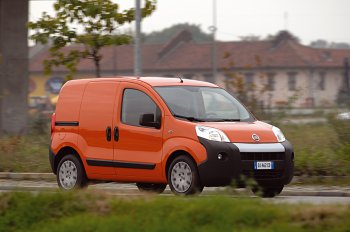
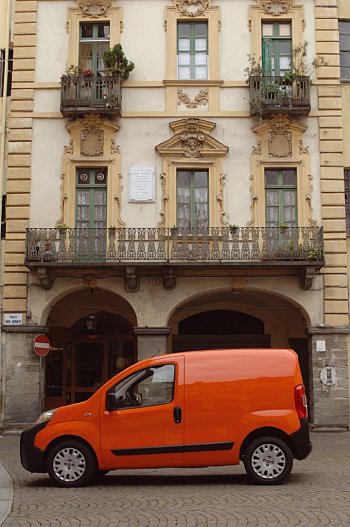
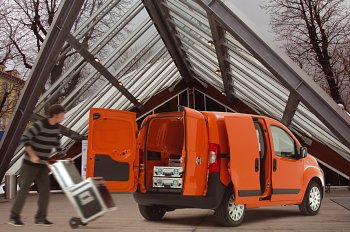 |
|
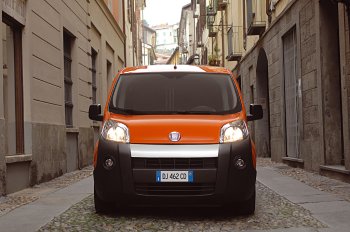
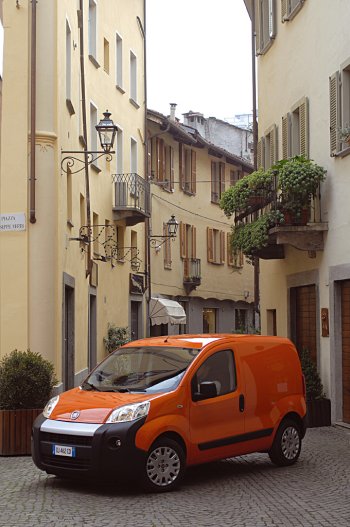
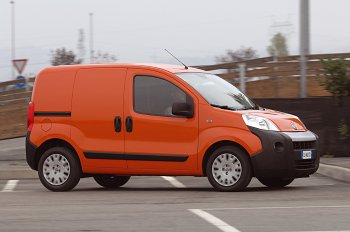 |
|
Maximum safety and low repair costs
The most expensive body parts are the headlights, bonnet and
bumpers. This is why these elements on the new Fiorino have
been positioned away from the area affected by impact: they
are set back approximately 100 mm from the external edge of
the front bumper so that they are not vulnerable to damage
in low-speed impacts against walls or pillars. In
particular, the Fiorino’s bonnet and headlights are set
higher than any other vehicles in its class. Inexpensive
repair kits are available for the headlights and radiator
grille, which cuts down on repair costs if the damage is
limited to the mounting and the functioning of the component
has not been affected.
The side doors have been designed to ensure that they
do not open accidentally on impact, but can be opened easily
after the event. In particular, they contain high-resistance
steel bars designed to boost protection in the event of side
impact. Collapse points and restraining hooks incorporated
into the bonnet prevent it from detaching and penetrating
the windscreen in the event of an accident. In an impact at
low speed, the oversized, smooth-edged mouldings provide the
maximum protection for the vehicle, while the side mouldings
are easy to remove, hence inexpensive to repair.
The lower shaft of the driving column is telescopic, so that
in the event of an accident, the wheel is not pushed up or
backwards towards the driver. To protect the driver’s legs
from impact against the steering wheel, the lower section of
the facia is made from high energy-absorbing materials. Last
but not least, a 9-bar steel bulkhead is available (standard
or optional depending on the market), to protect the driver
against moving or falling cargo. Various types of partition
are available: panelled, glazed or half-panelled,
half-grille (panel up to seat belt height with a grille
above) or a 2-part grille (one fixed, one revolving),
combined with the fold-away passenger seat.
Seats and seat belts
The seats of the new Fiorino have been designed to boost the
protective effect of the “real” safety features, in the
event of a collision. Rigid crosspieces have been
incorporated under the padding on the front seats. In the
event of a frontal impact, they have an anti-submarining
effect, providing the correct support to the occupants and
preventing them from slipping down below the seat belt. The
head rests have been designed to offer total safety as well
as a good level of comfort.
As regards passenger restraints, the new model is fitted
with 3-point seat belts for all positions. In particular,
the belts in the front seats are height-adjustable and come
complete with pre-tensioning devices and load limiters. In
the event of an impact, the electronically-controlled
pyrotechnic pretensioner reels in the belt in just a few
seconds, ensuring that it fits perfectly to the body. The
front reeling drums contain the controlled-release load
limiters which measure the force exercised by the belt on
the wearer’s shoulder.
Fire Prevention System
The FPS is designed to protect the vehicle against the
possible risks of fire. The main components of the system
include the inertia switch. In the event of a heavy impact,
the switch instantly shuts off the electric pump in petrol
vehicles, and the electrovalve in diesel models. This causes
the pressure in the fuel pipes to drop, preventing fuel
leakage. Special care has also been dedicated to the layout
of components and units (engine compartment, electrical
system, fuel and brake supply), which could be damaged due
to a fault or an accident.
Parking sensors
The Fiorino can also be fitted with rear parking sensors,
which are automatically activated when reverse gear is
engaged (there is also a switch so they can be deactivated).
This helps manoeuvring in tight spaces or where visibility
is particularly poor, by highlighting the presence of
obstacles behind the vehicle, out of the driver's field of
vision. Four ultrasonic sensors built into the rear bumper
“survey” the area behind the vehicle and relay the
information to a control unit that processes the data and
detects the presence of potential obstacles. The driver is
alerted by an intermittent acoustic signal. The frequency of
the sound is inversely proportional to the distance of the
obstacle (below 30 cm the signal is continuous).
Anti-intruder and theft
protection
Some of the most interesting features on the new Fiorino
include the anti-intruder devices, starting with the
separate locking system for front and rear doors, so that
the loading area can be used even when the cab is locked.
Load protection is also assured by the remote-controlled
central locking. These features, together with the deadlock
and Fiat CODE II immobiliser allow the vehicle to comply
with the highest standards of Thatcham security assessments.
Deadlock
This is an advanced security system that disables the
internal door handle and all the related mechanisms. It is a
major step forward in the field of vehicle protection, as it
renders useless any attempt by thieves to force the door and
lock mechanisms. The device, which comes as standard on all
right-hand drive models (optional for left-hand drive) must
be activated intentionally (so that nobody is locked inside
the vehicle). After the first signal from the remote
control, a second signal will activate the deadlock.
Fiat CODE II immobiliser
The new vehicle comes with a standard electronic Fiat CODE
II key, which varies the access code each time it is used.
Fiat CODE II prevents the engine from being started without
the vehicle’s original key. The grip incorporates a
transponder containing an electronic code that authorises
start-up by sending a secret code when interrogated by the
electronic control unit. The code is not fixed, but changes
each time the engine is started. The code is transmitted in
encrypted form by means of a secret algorithm (there are
billions of combinations). The system offers total security.
The secret code is never revealed to anyone, either at the
factory or the key supplier, and the decrypting algorithm is
never found in any of the components installed on the
vehicle, so cannot be copied. However, in the event of
malfunctioning, it can operate with an emergency program
that uses the accelerator pedal to transmit a specific code
shown on the CODE Card, known only to the owner.
Alarm system with dual
protection
On request, the new Fiorino can be fitted with a
dual-protection alarm system, for the outside of the
vehicle, thanks to the sensors on the movable parts (doors,
bonnet and rear doors), and on the electrical system, and
for the inside, by means of ultrasonic sensors that detect
movements inside the cab (for vehicles fitted with
partitions, the rear section is not covered by the sensors). |
|